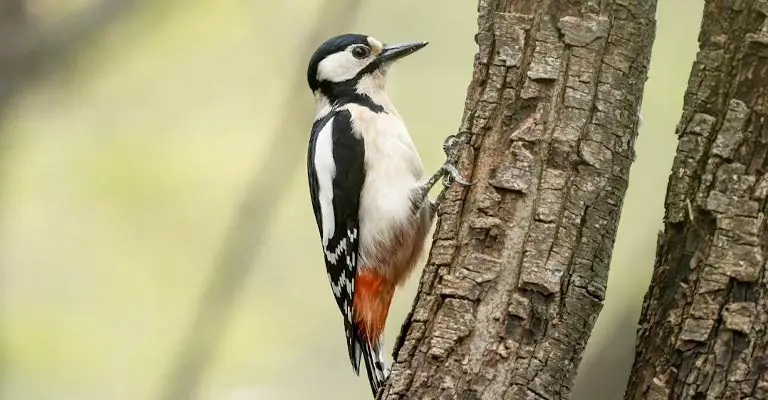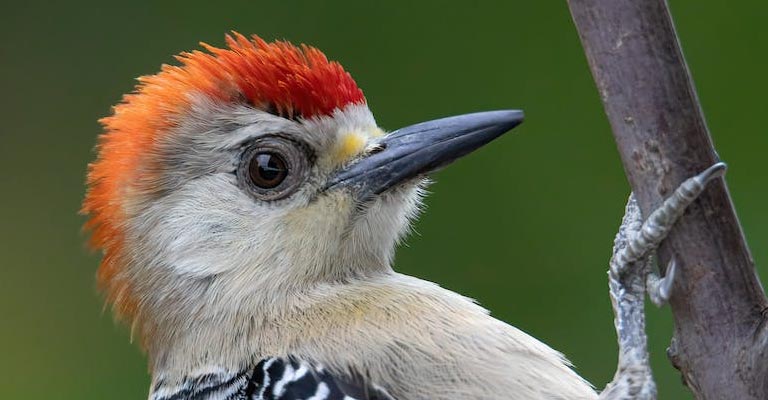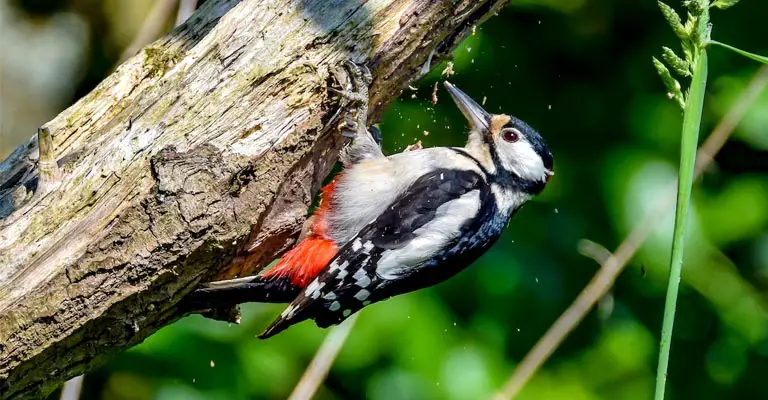Woodpeckers possess a remarkable ability that has puzzled ornithologists. These small but tenacious birds can hammer away at tree trunks and branches with astonishing precision, seemingly knowing exactly where to strike. But how do woodpeckers know where to peck?
How do woodpeckers locate hidden insects and tap into the heartwood of trees with pinpoint accuracy, all while avoiding injury to themselves?
In this exploration of the extraordinary instincts of woodpeckers, we delve into the fascinating world of these avian architects.
From the sensory adaptations that enable them to detect the faintest vibrations to the intricate neural pathways guiding their strikes, we will uncover the secrets behind their uncanny ability to find the perfect spot to peck.
By understanding the mechanics of this rhythmic drumming, we gain valuable insights into the remarkable adaptations of nature’s percussionists, shedding light on the evolutionary marvel that is the woodpecker.

How Do Woodpeckers Know Where to Peck?
One of the key sensory adaptations that enable woodpeckers to know where to peck is their exceptional hearing. Woodpeckers possess a highly developed sense of hearing that allows them to detect subtle sounds and vibrations within the wood.
They use their auditory senses to locate insects and other potential prey hiding beneath the tree’s bark. When a woodpecker drums on a tree, it listens for variations in sound and resonance that indicate the presence of insects moving beneath the surface.
By discerning these auditory cues, woodpeckers can pinpoint the exact location to strike. Here are some other aspects:
Vibrational Detection
In addition to their acute hearing, woodpeckers have specialized sensory structures that help them detect vibrations. Their stiff, pointed tail feathers act as sensors, transmitting vibrations from the tree to the bird’s central nervous system.
This sensory adaptation allows woodpeckers to feel the vibrations caused by the movements of insects under the bark, helping them precisely locate their prey.
By combining their sharp auditory perception with vibrational feedback, woodpeckers can hone in on the precise spot where insects are hiding.
Remarkable Brain Function
Woodpeckers have brains that are well-equipped for their unique pecking behavior.
The part of their brain responsible for processing sensory information is highly developed, allowing them to interpret the auditory and vibrational signals they receive from their environment with exceptional precision.
This finely-tuned sensory processing enables woodpeckers to make split-second decisions while pecking, ensuring they strike in the right place.
Rapid Decision-Making
Woodpeckers’ impressive ability to know where to peck is also a result of their rapid decision-making. They can adjust their striking location in real time based on the feedback they receive from their senses.
This quick decision-making process minimizes the risk of injury to the bird and maximizes their chances of a successful strike. It’s a testament to the efficiency of their neural pathways, which evolved over time to perfect this distinctive behavior.
Strong Beaks

Woodpeckers have evolved powerful and robust beaks that are designed for their pecking behavior. Their beaks are not only strong but also well-suited for penetrating the hard outer layers of trees.
These beaks enable woodpeckers to chisel away at the wood with precision, allowing them to access the insects hidden beneath the bark. The strength of their beaks is essential for their survival and their ability to forage for food.
Shock-Absorbing Anatomy
Another critical aspect of woodpeckers’ pecking success is their shock-absorbing anatomy. The force generated when a woodpecker strikes a tree at high speed is immense, yet these birds are well-equipped to handle it.
Their skull is uniquely designed to dissipate and absorb the impact forces, preventing brain injury and ensuring their safety during the powerful strikes.
In fact, the bones and tissues in their heads act as shock absorbers, providing a buffer against the forces generated during pecking.
Innate Instincts
Woodpeckers are born with innate instincts that guide their pecking behavior. While they refine their pecking skills through practice and experience, there is an inherent drive to tap into the wood.
This instinctual behavior is critical for their survival, as it allows them to access hidden insect larvae and create nesting cavities. The combination of innate drive and sensory adaptations ensures that woodpeckers instinctively know where and how to peck from a young age.
Learning Through Experience
While woodpeckers have strong instincts, they also learn and adapt through experience. As they peck on various surfaces and encounter different types of trees and insects, they refine their skills.
They become more efficient at finding the right spots to peck and adjust their techniques based on the feedback they receive from each encounter. Over time, they become masterful foragers and cavity creators.
Ecological Importance
Ecosystem Engineers
Woodpeckers play a vital role in their ecosystems as “ecosystem engineers.” By creating cavities in trees, they provide shelter for various species, including other birds and mammals.
Additionally, the holes they excavate often lead to increased tree decay, which further supports a range of organisms. Woodpeckers’ pecking behavior, and their ability to know precisely where to strike, have far-reaching ecological implications.
Natural Pest Control
Woodpeckers are natural pest controllers. Their ability to locate and extract insects from trees helps regulate insect populations in forests. By reducing the number of harmful pests, woodpeckers contribute to the overall health and balance of their habitat.
How Fast Do Woodpeckers Peck?

Woodpeckers are renowned for their rapid and rhythmic pecking on tree trunks and branches. Their ability to strike with incredible speed and precision is a testament to their unique adaptations and behaviors.
Let’s explore the fascinating world of woodpecker pecking, shedding light on just how fast these birds can tap into the wood.
Extraordinary Speed
The speed at which woodpeckers peck is astonishing. These birds are capable of delivering an impressive number of blows in a very short amount of time.
On average, a woodpecker can peck at a rate of 10-20 strikes per second, depending on the species and the specific circumstances.
Rapid Fire Pecking
When foraging for insects, woodpeckers employ a rapid-fire pecking technique. They can peck continuously and rapidly, drumming on the tree trunk to locate and access their prey. This blistering pace is a result of their highly evolved musculature and nervous system.
Woodpeckers have powerful neck and shoulder muscles that allow them to strike with great force and speed. Their nervous system is finely tuned to control these rapid movements, ensuring precise strikes.
Variable Pecking Speed
While the average pecking speed for woodpeckers falls in the range mentioned earlier, it’s important to note that different woodpecker species may exhibit variations in their pecking speed.
Some species, like the Hairy Woodpecker (Picoides villosus), have been observed to peck at a slightly slower rate, around 8-12 strikes per second.
On the other hand, the smaller Downy Woodpecker (Picoides pubescens) might peck at the higher end of the range, with rates closer to 15-20 strikes per second.
The Mechanics of Pecking
Woodpeckers’ rapid pecking is made possible by a combination of physical adaptations and neurological prowess:
Specialized Beak
The woodpecker’s beak is one of its primary tools for pecking. It’s incredibly sturdy and sharp, enabling it to penetrate the hard outer layers of trees with ease.
The beak’s chisel-like shape, reinforced with tough cartilage, allows woodpeckers to create holes quickly and efficiently. Their beaks are finely adapted for pecking at high speeds without dulling or fracturing.
Shock Absorption
The incredible speed at which woodpeckers peck generates substantial forces. To protect their brains from injury, woodpeckers have evolved remarkable shock-absorbing mechanisms. Their skull bones are spongy, and their beak strikes are delivered with precise control.
These adaptations help dissipate and absorb the impact forces, preventing brain damage. Woodpeckers effectively minimize the risk of injury, even when pecking at high speeds.
Precision Strikes
In addition to their physical adaptations, woodpeckers exhibit a high level of control and precision during their strikes. They rely on their acute senses, including exceptional hearing and the ability to detect vibrations, to locate insects beneath the tree’s bark.
This sensory input guides their strikes, allowing them to peck in precisely the right spots to access their prey. Their rapid strikes are not haphazard but purposeful, directed by their keen instincts and sensory feedback.
Evolutionary Necessity
The extraordinary speed at which woodpeckers have evolved as a necessity for their survival. These birds have adapted to a niche ecological role that demands efficient foraging for insects hidden deep within trees.
To access their prey, woodpeckers need the speed and power to break through the wood’s hard surface quickly. Their unique adaptations have allowed them to excel in this specialized feeding strategy.
FAQs
Are woodpeckers’ rapid pecking movements harmful to their brains?
Woodpeckers have evolved a series of adaptations to prevent brain injury while pecking at high speeds. Their skulls are designed to dissipate and absorb the impact forces, and they have shock-absorbing tissues in their heads.
Do all woodpecker species peck at the same rate, or does it vary?
Pecking rates can vary among woodpecker species. Larger woodpeckers, such as the Northern Flicker, may peck at a slightly slower rate, while smaller species, like the Downy Woodpecker, tend to peck at higher speeds.
Do woodpeckers only peck on trees, or do they also peck on other surfaces?
Woodpeckers primarily peck on trees and wooden structures, as their specialized beaks are well-suited for penetrating the hard outer layers of trees. While they may occasionally drum on other surfaces, it’s less common.
Can woodpeckers damage healthy trees when creating nesting cavities?
Woodpeckers typically select trees that are already compromised or decaying for creating nesting cavities. Healthy trees are not their primary targets. By choosing trees with softer wood, woodpeckers minimize the damage they cause.
Do woodpeckers have any predators or threats while they are engaged in pecking behavior?
Woodpeckers have a few natural predators, such as hawks and owls, but these predators typically target woodpeckers when they are not engaged in pecking.
Conclusion
The woodpecker’s exceptional ability to know where to peck is a testament to the marvels of evolution. Through a combination of finely tuned senses, these birds have adapted to their arboreal lifestyle with astonishing precision.
As we conclude our journey into the world of woodpeckers, we not only gain a newfound appreciation for their remarkable instincts but also a reminder of the diversity of life on our planet.
Nature’s solutions to the challenges of survival are as diverse as the species themselves, and the woodpecker’s ability to find the perfect spot to peck is just one of countless wonders waiting to be explored in the natural world.
It serves as a reminder that every species, no matter how small or seemingly ordinary, has its own unique adaptations and secrets waiting to be uncovered by those willing to explore the mysteries of the natural world.